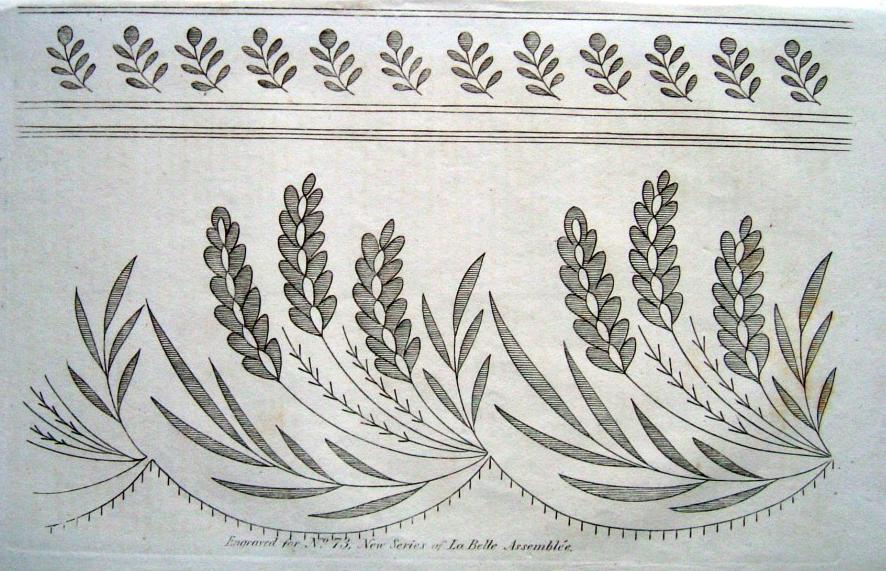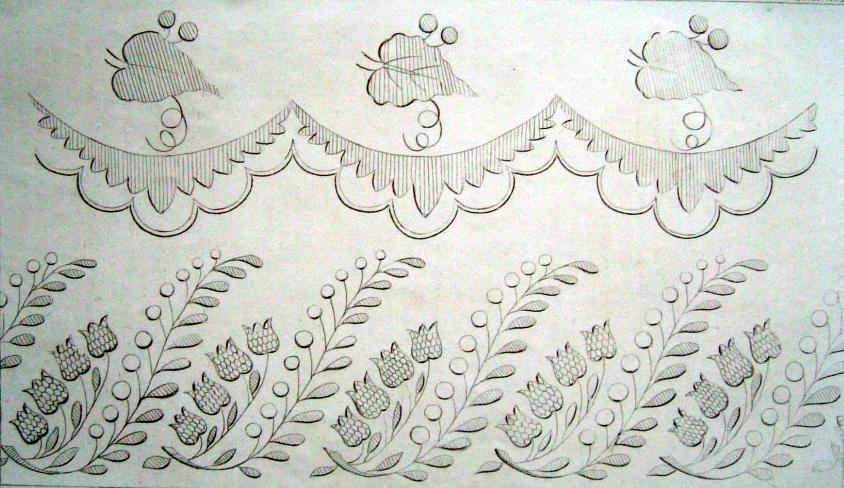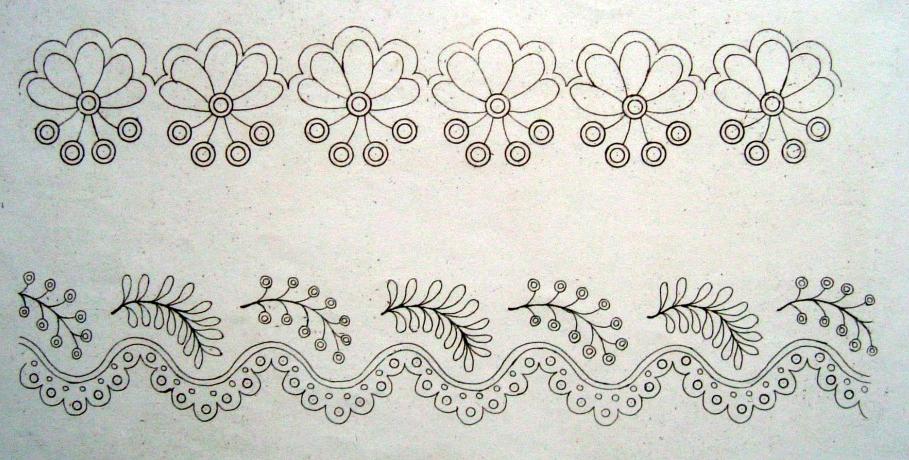A Review by Brenda S. Cox
“I was all in a fright for fear your sister should ask us for the huswifes she had gave us a day or two before”—Anne Steele, Sense and Sensibility, chapter 38
Christmas Ideas
I just finished a fall design, perfect for November. It adorns a “housewife” (or “huswife”) sewing organizer I’ll give as a Christmas gift. If, like me, you enjoy sewing gifts for people, Jane Austen Embroidery will give you great ideas and patterns. Or, if you want something for a Jane Austen fan, or for someone who enjoys sewing and embroidery, the book itself would be a great gift for them!
Jane Austen Embroidery
Jane Austen Embroidery: Regency Patterns Reimagined for Modern Stitchers, by Jennie Batchelor and Alison Larkin, is a gorgeous book. With glossy pages full of beautiful photos, it’s a delight to read. I have done cross-stitch for many years, and dabbled in other kinds of embroidery, so I enjoyed learning more about stitching in Austen’s England.

The book begins with an introduction exploring “Embroidery in Jane Austen’s Britain.” We learn about Austen’s enjoyment of needlework (which was often just called “work,” in her novels and elsewhere). Some of her contemporaries, including Mary Wollstonecraft, complained that it was drudgery and meaningless work. However, Austen’s letters show that she enjoyed style and had fun fashioning trimmings and garments.
The Lady’s Magazine
The Lady’s Magazine (1770-1832) is the source for the designs in the book. The authors explore the magazine’s history. It covered politics, science, cosmetics, essays, travel writing, poetry, serialized novels, music, and much more. According to Jane Austen Embroidery, The Lady’s Magazine balanced “traditionally feminine and intellectual accomplishments,” encouraging women to take up “the pen, as well as the needle.” Austen did both!
Embroidery patterns in the magazine were usually removed for use. It took the authors five years to track down sixty issues which still had intact patterns.
Readers of the magazine used the patterns with their own choices of colors, sizes, materials, and applications. Jenny Batchelor and Alison Larkin have adapted the patterns to modern materials and uses. They give detailed instructions.

Overview of Jane Austen Embroidery
Seventeen pages explain in clear detail your options for tools, fabrics, thread, transferring the patterns to fabric, framing, working the stitches, and finishing your projects. I read this all the way through; even experienced stitchers will find helpful ideas here.
Three main sections make up the book: “Embroidered Clothes: Dressed to Impress,” “Embroidered Accessories: How Do You Like My Trimming?”, and “Embroidery for the Home: A ‘Nest of Comforts.” Each begins with an extensive discussion of uses of embroidery in Austen’s England aas well as references in her novels and letters. For example, the authors say that in Northanger Abbey, when Henry Tilney was telling Catherine what she might write in her journal, he was complimenting her in an indirect way. He said that she “appeared to much advantage” in her “sprigged muslin robe with blue trimmings.” Sprigs were flowers or sprays of flowers, hand embroidered or printed onto the fabric.
Sewing Projects
Each section offers five projects with detailed instructions. Projects are marked “Beginner,” “Intermediate,” and “Advanced.” I didn’t notice this until I had already bought the material for an “Advanced” project, but I decided to go with it anyway!
For Beginners, in the first section the book offers a “simple sprig pattern” of two flowers on a stem, and a beaded pencil case with a swirling design from a gown pattern. Intermediate stitchers might sew a sequined evening clutch purse, embroidered from a waistcoat pattern, or an apron with an intricate “fireflower” pattern. Advanced stitchers can try a “housewife” sewing organizer decorated with an autumn pattern.
Later sections offer a napkin set, cell phone pouch, tablet sleeve, reticule or jewelry pouch, muslin shawl, tea box top, work bag, cushion, sewing set, and tablecloth. All are lovely.

The book tended to go a little freely between Austen’s time and modern times, so I wasn’t always sure whether techniques, materials, and designs were modern or traditional. But I was usually able to figure it out. Also I would have liked a few more pictures of embroidered items of Austen’s time; these were discussed but few were shown. Though I suppose more pictures would have added to the expense of the book, and it’s not too difficult to find pictures online.
The projects that interest me most were items actually used in Austen’s time: the housewife, reticule, shawl, tea box top, work bag, and sewing set. But modern stitchers might enjoy making things they can use daily, like a cell phone pouch or a tablet sleeve. There are plenty of options!

The Housewife (Huswife or Hussif)
To really try this book out, I decided to make the Harvest Housewife. A “housewife”—pronounced “hussif”—was “a folded, rolled purse-like object with internal compartments for carrying needles and needlework accessories” (66). It could also be used for carrying coins, letters, and other items. Miss Bates finds a letter under her housewife or huswif in Emma.

We also know that Jane Austen made a housewife for her friend Mary Lloyd, which Jane’s nephew James-Edward Austen-Leigh described in his Memoir of Jane Austen.
He wrote:
“Her needlework both plain and ornamental was excellent, and might almost have put a sewing machine to shame. She was considered especially great in satin stitch. She spent much time in these occupations, and some of her merriest talk was over clothes which she and her companions were making, sometimes for themselves, and sometimes for the poor.
There still remains a curious specimen of her needlework made for a sister-in-law, my mother. In a very small bag is deposited a little rolled up housewife, furnished with minikin needles and fine thread. In the housewife is a tiny pocket, and in the pocket is enclosed a slip of paper, on which, written as with a crow quill, are these lines:
‘This little bag, I hope, will prove
To be not vainly made;
For should you thread and needles want,
It will afford you aid.
‘And, as we are about to part,
‘T will serve another end:
For, when you look upon this bag,
You’ll recollect your friend.’
“It is the kind of article that some benevolent fairy might be supposed to give as a reward to a diligent little girl. The whole is of flowered silk, and having been never used and carefully preserved, it is as fresh and bright as when it was first made seventy years ago; and shows that the same hand which painted so exquisitely with the pen could work as delicately with the needle.”
As far as I can find out, that housewife is no longer around; at least, I could not find pictures of it. The Jane Austen House Museum does have a little needle case, made of cardstock and felt, which Jane Austen made for her niece; that would be fun to try to recreate.

My Project
The housewife was definitely an advanced project. Putting together all the pockets and attachments inside was complicated. I asked Alison for a photo of the finished product to help me out, which she cheerfully supplied (see my blog). In the end, however, I made my own modifications to it, so it would hold cross-stich supplies. That was fun and worked well.
The samples in the book are beautifully hand-sewn with silk fabric and threads. However, my money and time are limited, so I decided to use cheaper fabric, DMC thread, and a sewing machine. I spent less than $20. The book lists substitute colors for those who want to use DMC or Anchor thread instead of silks.
I was very pleased with the results. For details, see my post on my blog. My experience shows that you do not need to be an expert stitcher, or spend a lot of money, to make beautiful projects with this book.
Next I may make an easier project, for myself.
Check this book out if you love sewing and love Jane Austen. Or, give it to your friends who do.
Happy sewing!
Jane Austen Embroidery by Jennie Batchelor and Alison Larkin is published by Dover Publications in the US and Canada, and by Pavilion Books in the UK.
Photographs from the book are by Penny Wincer; used by permission.
You can find Jennie’s fascinating talk on “Crafting with Jane Austen” at Jane Austen & Co. (Go down to the Staying Home with Jane Austen series, then click through the videos listed horizontally below that until you get to “Crafting with Jane Austen.”)
Jennie Batchelor’s website also links to other talks she has given.
Alison Larkin’s website includes blog posts on Georgian embroidery and lovely images.
See also my post on Making a Housewife Sewing Organizer.





























